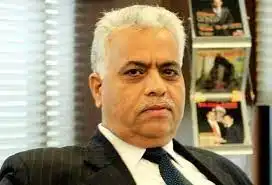Union Finance Minister Nirmala Sitharaman introduced the Finance Bill 2022 in Parliament, following which the Lok Sabha was adjourned till tomorrow. Finance Minister Nirmala Sitharaman today presented the Union Budget 2022 in the second year of the COVID-19 pandemic. “We strive to provide necessary ecosystem for middle class. This Budget hopes to lay the foundation for Amrit Kal from India at 75 to India at 100,” Ms. Sitharaman said today. Here are the industry reactions post union budget 2022 declaration.
Industry reactions on Union Budget 2022
Ramesh Nair, CEO, India and Managing Director, Market Development, Asia, Colliers.
Announcements such as 25,000 km of new highways, Gati Shakti Masterplan for expressways, 100 new cargo terminals and initiatives to connect urban transport to railways will give a big boost to new warehousing and logistics facilities across the country.

The Budget made several announcements to spur growth of the logistics sector in the country. The Budget announced that about 25,000 km of new highways will be built this year. Moreover, Gati Shakti Masterplan for expressways,100 new cargo terminals for multi-nodal logistics, and development of urban metro systems will give a big boost to new warehousing and logistics facilities across the country. The government also extended the ECLGS up to March 2023. This will go a long way in supporting the MSME sector and revive industrial activity. This has immense scope to drive demand for warehousing and logistic sectors. The government repealed about 1,490 union laws, paving the way to enhance ease of doing business. The government also plans to launch ‘Ease of Doing Business 2.0.’ This should include more dynamic aspects and make India a more investment friendly destination.
Announcements such as 48,000 crores for PMAY, 80 lakh homes under PMAY, single-window environmental approvals, better co-ordination between the centre and states for approval processes and uniform registration of deeds will help boost the affordable housing market
Ajay Sharma, MD, Valuation Services, Colliers India

ECLGS extended up to March 2023 would support the MSME sector and keep the industrial activity up which in turn will push demand for warehousing and logistic sectors
E -education service providers will see expansion with government pushing for supplementary education schemes across India
Digital payments players will keep expanding due to budgetary support extended till 2023. Environmental approvals will become transparent with single window tracking
Piyush Gupta, MD, Capital Markets and Investment Services, Colliers India

The concept of India @ 100 introduced in the Budget has set the foundation stone for India’s growth story over long term. The Gati Shakti national master plan spruced by seven engines of Infrastructure shall go long way in developing multi modal network to create world class infrastructure with full support on planning, financing, innovation and technology. The Government spending and Private Investment shall create jobs at one end and also provide opportunities to Investors. This will provide sunrise opportunities relating to energy transition, climate action, financing of Investments.
Saransh Trehan, MD, Trehan Group
Finance Minister Nirmala Sitharaman’s historic budget is an optimal blend of optimism and realism which will take the country to a higher growth trajectory. May it be agriculture, infrastructure or any other sector, the budget has laid down a clear roadmap for New India and a prosperous Bharat.
Suren Goyal, Partner, RPS Group
Finance Minister Nirmala Sitharaman deserves congratulations for pulling all the right strings in her budget. The emphasis on the infrastructure sector will boost growth in the medium to long term and will help the country in maintaining its position as the fastest growing major economy in the world. Revamping of SEZ Act will also assist in the growth of the economy
Shyam Arumugam, Managing Director, Industrial and Logistics Services, Colliers India

“The budget speech places thrust on clean technology in public transport, with plans to develop special mobility zones for electric vehicles and the introduction of a new battery swapping policy. This is a welcome move to facilitate further growth of EVs, as India moves towards its sustainability goals. The EV space in India is likely to see investments of INR94,000 crore (USD12.6 billion) across the automotive value chain, over the next five years. A Much needed investment of additional allocation of Rs 19,500 crore for PLI for manufacturing of high-efficiency modules with priority to fully integrate manufacturing units to solar PV modules will be made to boost the domestic manufacturing of 280 gigawatts of installed solar capacity by 2030. A battery swapping policy would address the key concern for the charging infra. The policy aims to address the constraints of space in urban areas for setting up charging stations. Also since battery contributes to approx. 40% of EV input cost the same would enable faster EV adoption. This is a “game-changer” for EV adoption”.
Vimal Nadar, Head of Research, Colliers India

“The budget announced a few laudable incentives for startups. The period of incorporation has been extended by a year to March 2023 to avail of tax benefits. For corporates, extension granted for new companies to set up manufacturing facilities to 2024 from earlier 2023. These will provide a breather for start-ups and encourage more start-ups in India. India is becoming the hub for entrepreneurship, with India’s start-up story growing from strength to strength. Around 14,000 start-ups were recognized during the financial year 2022, with about 555 districts in India had at least one new startup. We are already seeing ample evidence of the start-up activity in the commercial office space. During 2021, in the top three cities of Delhi-NCR, Mumbai and Bengaluru, start-ups leased about 2.2 million sq feet of space during 2021, a 56% rise from 2020”.
Subhankar Mitra, Managing Director, Advisory Services, Colliers India

“The total effective Capex spend by the government is about 10.7 lakh crore. There is an emphasis on PM Gati Shakti mission which is targeted towards improving connectivity and logistics infrastructures of the country. On the Reform side most significant shift is towards City Planning. The budget emphasizes on modernization of Building By laws, Digitization of land records and also enabling registration of properties of any location. The budget casts its attention towards training and development of urban planning practice by ways of setting up six centre of excellence with budgetary support. Since land is mostly state subject , hence a special interest free loan for 50 years is offered to the state government who would participate in the reform process announced by the central government. It is expected to incentivise the state governments to collaborate with the centre to fast track the reforms.
Budget is also focuses on encouraging digital drive and fintech. The issuance of digital currency by the RBI and by brining Data centre in infrastructure category is expected to boast the fintech and digital drive of the nation. Setting up of International tribunal in GIFT city will help corporate sector to address any disputes in cost effective manner, it will also help in promoting India as an attractive investment destination.
The Budget is focused on the futuristic technological shifts, it also attempted to ease of doing business, encouraging private sector investments and job creation.However, there is not much of focus on the consumption side. Nothing significant in the proposal to boost discretionary spend at the household level, which could boost sectors like retail, hospitality, F&B, leisure and entertainment”.
R K Arora, Chairman, Supertech Ltd

Government has treaded a line of fine balance to lead the economy to high GDP growth rate by investing in infrastructure sector, yet keeping the fiscal deficit within manageable limits. In the backdrop of ambitious ‘housing for all’, PMAY has been given due importance, however largely through Government’s flagship programmes rather than the incentives real estate development companies were hoping for.
Mr. Dilip Oommen, President, Indian Steel Association.

“It is a visionary budget that lays a blueprint for ‘Amrit Kaal’, supported by PM Gati Shakti Mission with multi-modal approach to boost transport & logistics. A significant increase of 35.4% in capital expenditure to Rs 7.50 lakh crore will also have a multiplier effect and provide impetus to drive growth, thus helping in steel demand creation. Increase in the domestic capital procurement budget for the Armed Forces’ equipment is yet another right step towards realising the Atmanirbhar Bharat mission. Focus on sustainability that emphasises on socio-economic development along with the circular economy is a positive move” says Mr. Dilip Oommen, President, Indian Steel Association.
Mr. Gautam Thacker, President, NAREDCO – Progressive Neral-Karjat Unit.

The union budget for 2022 looks promising and balanced. It has more or less provided each sector with some benefits which will help the businesses to overcome certain uncertainty. Announcements such as 48,000 crores for PMAY, 80 lakh homes under PMAY will help boost the affordable housing market. Besides this, the government (Central and State) has designed various schemes, such as Pradhan Mantri Awas Yojana (PMAY) with the aim to build one crore homes in urban and rural India by 2022 which will further boost the boost affordable housing and achieve the vision of Housing for all by 2022 – 2023.
The Central Government in tandem with the state governments needs to align the process in order to reduce the time period required for all land and construction-related approvals. Having said that the government’s move to develop urban planning with the adoption of public transportation will help the housing sector grow. The govt initiative of subsidy on housing loans through the Credit Linked Subsidy Scheme (CLSS) is benefitting the masses opting for affordable housing.
The announcement of the extension of ECLGS to help MSMEs cope with pandemic losses is a progressive move by the government with a goal to strengthen the economy and boost employment generation
Mr. Surendra Hiranandani, Chairman and Managing Director, House of Hiranandani
“Budget 2022 has set the tone for the modern India that will be built on a strong foundation of planned cities with high capital expenditure towards a robust network of infrastructure and technology.

Honourable Finance Minister Nirmala Sitharaman’s focus on redefining urbanization through urban building policy and setting up of a high-level expert committee is a welcome move. Our cities have been built with the age-old laws and there was a dire need to refurbish them as per modern day to day requirements and needs. The focus on modernizing building / infrastructure laws and town planning displays that we are gearing to envision a new India with smart and tech-led planned cities.
Allocation of Rs 48000 cr towards affordable housing reassures the Government’s focus on housing. Equal focus on infrastructure, sustainability, technology, will have a multiplier effect by creating more job opportunities and consumption demand.
Real Estate sector has been largely impacted due to the pandemic. There were some expectations from the sector that would have boosted demand and offered increased deductions towards the principal/ interest payment of home loans. There was a need to increase the scope of affordable housing by raising the cap of Rs 45 Lakhs for metros. This would have increased the scope of affordable housing and a large number of home-buyers could have then benefitted from the subsidies available for this segment.
An infrastructure status has been a long pending demand of the sector. It would have made a major difference in accessing capital at a reasonable cost. Nevertheless, we appreciate the government’s focus on overall developments of the nation. We are optimistic and look forward to witnessing the beginning of a new and robust economy.”
Harresh Mehta, CMD, Rohan Lifescapes

“Union Budget 2022 has further given impetus to the growth of the housing sector in India. Continued emphasis on urban planning by adopting modern laws will boost the development of the segment in the near future. Also, the government planning to launch ‘Ease of doing business 2.0’ will add different flavors with more dynamic aspects to make India a lucrative destination for investment. Overall, the budget proves to be a helping hand for more or less all the sectors keeping the current disruption in mind.”
Ujjwal Jain, CEO and Founder, WealthDesk:

“The government continued with a growth-oriented budget and took charge from the front. This can be seen by the 35.4% increase in CAPEX while maintaining a manageable fiscal deficit and very conservative tax revenue targets.
Make in India continues to get the push – To boost defence innovation, 68% of the capital procurement budget in defence will be earmarked for the domestic industry in 2022-23. The Unified Logistics Interface Platform (ULIP) was also announced in the budget speech, which will enhance efficiency and reduce logistics costs in the country.
The other highlight was the 30% tax on Virtual Digital Assets with no set-offs and TDS of 1%. Bringing the Virtual Digital Assets into the tax net is a smart move with a forward-looking approach. The Finance Minister also announced the creation of a digital currency by the RBI.
The government will form an expert panel to attract and encourage PE/VC investments. The panel will help identify the appropriate measures to increase investments and establish friendly policies for investors bringing foreign capital to Indian startups. This move can help reduce risks faced by foreign investors when investing in Indian startups.
In all, the key takeaway from the budget can be “Invest in India”.
Mr. Anil G Verma, Executive Director and President, Godrej and Boyce.

“The Budget for FY 2023 holds a lot of promise for the economy. It has a thrust for the social sector with investments in primary and vocational education, provision for drinking water to reach more households and the extension of the PM Awas Yojana to provide housing. In addition, its outlay for procurement of agricultural produce will reward the farmers for their effort and put money in their hands which will help to propel consumption demand.
The focus on the logistics sector through the PM Gati Shakti plan will give a fillip to the economy. Logistics costs in India count among the highest in the world. Creation of infrastructure is the best way to reduce the costs and introduce competitiveness in the economy to serve both the domestic market and exports. The initiative of spurring investments from the private sector by taking the lead through government investments of Rs. 7.5 lakh Cr. is laudable. The PLI scheme outlay for solar modules will support the solar power generation projects which are currently facing steep cost increases and supply constraints. Support for domestic manufacture of capital equipment by doing away with duty exemptions is also a welcome step.
Reforms in customs administration will no doubt support both the SEZs as well as other manufacturers in the domestic tariff area. Our SEZs are vulnerable to both disruptions in the global supply chain and also the emphasis on domestic sourcing that we increasingly see overseas. Permission to sell part of the capacity in DTA while maintaining a level playing field with domestic manufacturers will enhance scale and competitiveness whilst reducing reduce vulnerability.
The economy is on a slow recovery path. This budget seeks to accelerate the growth through investments.“
Yogesh Mudras, Managing Director, Informa Markets in India
“This year, the Union Budget has been one of recovery and stabilization from the impact of COVID-19. The Budget has taken some initiatives for MSMEs and India Inc for start-ups. The extension of ECLGS scheme is a welcome move for MSMEs. The tax concession period has been extended by one more year, which in my opinion is a very positive move. A tax rate of 15% has been decided for the newly incorporated manufacturing unit which will further boost manufacturing activities. Healthcare and infrastructure were the main highlights of Budget 2022 and immense investment has been allocated for the expansion of roadways and logistics networks.

Introduction of ‘Digital Rupee’ using blockchain technology sends a strong message that India is at the forefront of technology implementation. A digital currency issuance by the RBI will result in a structured approach with controlled regulation and bring in transparency to transactions enabling accounting of all money. The push on digitization will make way for more inclusion in the ecosystem. The focus on ‘Ease of doing business’ is a great step, as it will further promote entrepreneurship in the economy. India is to grow at 9.27%, the highest among all large economies. With a focus on contributing to the environment, chemical-free natural farming focusing on soil, biodiversity and human well-being is a welcome move. The budget is growth-oriented with an impetus on capital expenditure to fuel economic growth and employment generation. SEZ Act to be replaced with the new legislation is a much-needed announcement. Introduction of the battery swapping policy and recognizing battery and energy as a service will help to develop charging infrastructure and increase the use of EVs in public transportation. This would motivate businesses to incorporate EVs into their fleet and create new avenues for companies to venture into the business of battery swapping. The formation of a strong charging infrastructure alongside the highways across the country would promote the use of EVs for interstate travel. An additional allocation of Rs 19,500 crore to boost manufacturing of solar modules under the government’s flagship PLI scheme has the potential to create 60 lakh new jobs, while producing 30 lakh crore jobs during next five years. International travel has been severely impacted during the pandemic. We are pleased with the introduction of e-passports as it will provide a boost to the travel industry and add convenience. Extension of ECLGS scheme with an additional allocation for the hospitality sector is a positive move as it would help small and mid-size hotels overcome liquidity issues and pave way for growth.”
Mr. Sudarshan Lodha, CEO & Founder, Strata Property Management
Considering the importance laid on digitization of technologies and sectors, I would like to congratulate FM for promoting of use of deep tech and online interface across sectors to drive digitisation and ensure greater transparency. As real estate is the second largest contributor in employment generation and contributes over 10% of the total GDP, it is extremely encouraging to see budget laying policies for boosting infrastructure and introducing taxation benefits for real estate investments.

With real-estate encompassing for a huge chunk of LTCG, capping long term capital gains surcharges to 15 percent would encourage real estate investors to lock in their investments for a longer period, helping them maximize their gains. This will go a long way to accelerate the pandemic slowed real estate investments. Additionally introducing state partnerships in SEZ development hubs and scraping of SEZ Act would encourage businesses to stay longer driving growth and stability. Also extending tax concessions for startup community would help them revive their operations from the aftershock of pandemic
The budget has laid out a host of measures offering huge push to the infrastructure segment which will play a catalytic role in driving consumption, urbanisation, creating employment opportunities and thereby reviving growth in the aftermath of the pandemic. All in all it is an extremely futuristic budget with adequate focus on economic revival and growth.”
Aryaman Vir, Cofounder & CEO, Myre Capital

‘Budget 2022 is highly growth oriented that propels capital expenditure. The boost provided by the government on affordable housing will be beneficial to the continued housing demand post COVID-19 and will also encourage prospective buyers to avail more benefits and invest in real estate. With the initiation of the PM Gati Shakti, there will be a rise in infrastructure developments which will gradually lead to growth in commercial real estate sector and thus help in accelerating the economy as a whole. This will also create more employment opportunities for the youth of the country. The step taken by the government for urban development also focusing on Tier 1 and Tier 2 cities will facilitate businesses to expand across the country and rise to match the vision of a developed economy.”
Mr. Vivek Bhatia, Managing Director and CEO, thyssenkrupp Industries India

The Union Budget for the year 2022-23 will re-energize the infrastructure sector, including multi-modal transportations through the PM Gati Shakti. With Capital Expenditure at more than 4% of GDP and a renewed push in incentivizing various sectors like agriculture, manufacturing, health, digital education, and a big move for transition to clean energy, the budget will drive industrial growth in a big way. The creation of more efficient freight corridors through an additional 25,000 km of roadways, and the launch of a Unified Logistics Interface platform will not only be a major boost for the economy but iron out the gaps in both supply and demand. The renewed thrust on Make in India is expected to generate 6 million jobs, which is important in restructuring the economy with a digital push going forward. The additional allocation to the PLI scheme will certainly bring in more investments into the economy. Concessions in import duties on raw materials, and export incentives are the right moves to make India a global manufacturing hub. It is a very forward looking and progressive budget.
Mr. Raghunath K, Country Representative, thyssenkrupp India

The Union Budget reiterates the emphasis on public investment to modernize infrastructure over the medium term. While balanced, the budget is favourable towards the manufacturing industry and MSMEs, given their vital role in strengthening the Indian economy. It expands the scope and idea of the Atmanirbhar Bharat and the newly announced PLI schemes will give a fillip to India’s future growth story. The aim has been to veer towards new directions across multiple sectors like automobile, heavy engineering, and areas related to farm produce. This structural approach gives the right impetus and ensures a positive environment for a quick recovery in the aftermath of multiple waves of COVID. It will re-start the engine of growth and job creation. This budget is a practical and sustainable approach for the growth trajectory that India needs in the long term.
Mr. Vikas Bhasin, MD, SAYA Homes

“The Union Budget 2022-23 is progressive, providing a broad-spectrum boost to the economy, particularly with its emphasis on improving the country’s infrastructure. The government has increased the Capex target by 35.4 percent, from INR 5.54 lakh crore to INR 7.50 lakh crore, potentially boosting overall spending for economic growth. The budget also emphasises the importance of appropriate urban planning, while simultaneously providing some assistance to states and keeping the budgetary deficit in check. Another significant plus is that the government’s goal of creating 6 million new jobs over the next five years will allow residential real estate to expand across the country. In a post-covid era, it’s a good budget since it hasn’t altered the tax system, leaving individual discretionary incomes unaffected and the government has continued on its stated path to job creation. However, a few pressing issues in the real estate sector remain unaddressed such as granting the sector industrial status and tax breaks on home loans to enhance buyer confidence.”

